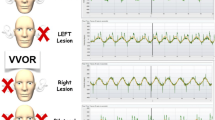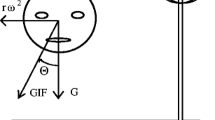Abstract
Opsoclonus refers to saccadic oscillations without an intersaccadic interval occurring in multiple planes. Opsoclonus mostly indicates dysfunction of the brainstem or cerebellum. We report opsoclonus induced by horizontal head-shaking without other signs of brainstem or cerebellar dysfunction in two patients with vestibular migraine (VM). The development of opsoclonus after horizontal head-shaking indicates unstable or hyperactive neural circuits between the excitatory and inhibitory saccadic premotor burst neurons in these patients with VM.


Similar content being viewed by others
Data Availability
The data supporting the findings are only available on request. The data are not publicly available due to privacy or ethical restrictions.
References
Leigh RJ, Zee DS. The neurology of eye movements. Contemp Neurol, 5th edn. 2015. pp. 657–768.
Ramat S, Leigh RJ, Zee DS, Optican LM. What clinical disorders tell us about the neural control of saccadic eye movements. Brain. 2007;130:10–35. https://doi.org/10.1093/brain/awl309.
Wong AM, Musallam S, Tomlinson RD, Shannon P, Sharpe JA. Opsoclonus in three dimensions: oculographic, neuropathologic and modelling correlates. J Neurol Sci. 2001;189:71–81. https://doi.org/10.1016/s0022-510x(01)00564-0.
Shaikh AG, Zee DS, Optican LM, Miura K, Ramat S, Leigh RJ. The effects of ion channel blockers validate the conductance-based model of saccadic oscillations. Ann N Y Acad Sci. 2011;1233:58–63. https://doi.org/10.1111/j.1749-6632.2011.06130.x.
Ramat S, Leigh RJ, Zee DS, Shaikh AG, Optican LM. Applying saccade models to account for oscillations. Prog Brain Res. 2008;171:123–30. https://doi.org/10.1016/S0079-6123(08)00616-X.
Lee JY, Kwon E, Kim HJ, Choi JY, Oh HJ, Kim JS. Opsoclonus following downbeat nystagmus in absence of visual fixation in multiple system atrophy: modulation and mechanisms. Cerebellum. 2021;20:724–33. https://doi.org/10.1007/s12311-019-01090-w.
Otero-Millan J, Optican LM, Macknik SL, Martinez-Conde S. Modeling the triggering of saccades, microsaccades, and saccadic intrusions. Front Neurol. 2018;9:346. https://doi.org/10.3389/fneur.2018.00346.
Ridley A, Kennard C, Scholtz CL, Buttner-Ennever JA, Summers B, Turnbull A. Omnipause neurons in two cases of opsoclonus associated with oat cell carcinoma of the lung. Brain. 1987;110(Pt 6):1699–709. https://doi.org/10.1093/brain/110.6.1699.
Eggers SD, Horn AK, Roeber S, Hartig W, Nair G, Reich DS, Leigh RJ. Saccadic palsy following cardiac surgery: possible role of perineuronal nets. PLoS One. 2015;10:e0132075. https://doi.org/10.1371/journal.pone.0132075.
Optican LM, Pretegiani E. A GABAergic dysfunction in the olivary-cerebellar-brainstem network may cause eye oscillations and body tremor. II. Model simulations of saccadic eye oscillations. Front Neurol 2017; 8:372. https://doi.org/10.3389/fneur.2017.00372
Kaski D, Bronstein AM, Edwards MJ, Stone J. Cranial functional (psychogenic) movement disorders. Lancet Neurol. 2015;14:1196–205. https://doi.org/10.1016/S1474-4422(15)00226-4.
von Brevern M, Lempert T. Vestibular migraine. Handb Clin Neurol. 2016;137:301–16. https://doi.org/10.1016/B978-0-444-63437-5.00022-4.
Huang TC, Wang SJ, Kheradmand A. Vestibular migraine: an update on current understanding and future directions. Cephalalgia. 2020;40:107–21. https://doi.org/10.1177/0333102419869317.
Radtke A, von Brevern M, Neuhauser H, Hottenrott T, Lempert T. Vestibular migraine: long-term follow-up of clinical symptoms and vestibulo-cochlear findings. Neurology. 2012;79:1607–14. https://doi.org/10.1212/WNL.0b013e31826e264f.
Shin JH, Kim YK, Kim HJ, Kim JS. Altered brain metabolism in vestibular migraine: comparison of interictal and ictal findings. Cephalalgia. 2014;34:58–67. https://doi.org/10.1177/0333102413498940.
Funding
This study was supported by the National Research Foundation of Korea (NRF) grant funded by the Ministry of Science and ICT (No. NRF-2021R1F1A1061527).
Author information
Authors and Affiliations
Contributions
M–K Kim analyzed and interpreted the data and wrote the manuscript. W–H Lee, X Yang, H-J Kim, and J-Y Choi analyzed and interpreted the data and revised the manuscript. J-S Kim designed and conceptualized the study, interpreted the data, and revised the manuscript. All authors reviewed the manuscript.
Corresponding author
Ethics declarations
Ethics Approval and Consent to Participate
This study was approved by the Institutional Review Committee of Seoul National University Bundang Hospital (B-2208–773-701), and informed consent for case report was obtained from the patient.
Conflict of Interest
Dr. J-S Kim serves as an associate editor of Frontiers in Neuro-otology and on the editorial boards of the Journal of Clinical Neurology, Frontiers in Neuro-ophthalmology, Journal of Neuro-ophthalmology, Journal of Vestibular Research, Journal of Neurology, and Medicine. Dr. J-Y Choi serves as an associate editor in Journal of Clinical Neurology. The other authors have nothing to disclose.
Additional information
Publisher's Note
Springer Nature remains neutral with regard to jurisdictional claims in published maps and institutional affiliations.
Supplementary Information
Below is the link to the electronic supplementary material.
Supplementary file1 (MP4 96028 KB)
Supplementary file2 (MP4 306547 KB)
Rights and permissions
Springer Nature or its licensor (e.g. a society or other partner) holds exclusive rights to this article under a publishing agreement with the author(s) or other rightsholder(s); author self-archiving of the accepted manuscript version of this article is solely governed by the terms of such publishing agreement and applicable law.
About this article
Cite this article
Kim, MK., Lee, WH., Yang, X. et al. Opsoclonus Induced by Head-Shaking in Vestibular Migraine. Cerebellum 23, 856–860 (2024). https://doi.org/10.1007/s12311-023-01571-z
Accepted:
Published:
Issue Date:
DOI: https://doi.org/10.1007/s12311-023-01571-z




